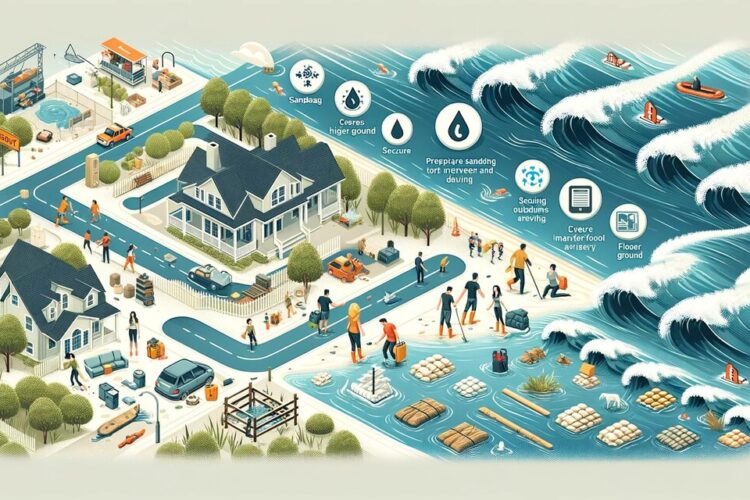Living near the coast has many perks, from beautiful ocean views to the soothing sound of waves. However, coastal living also comes with its own set of challenges, particularly when it comes to weather-related events like coastal flooding. When a coastal flood advisory is issued, it’s crucial to take it seriously and be prepared. This blog will help you understand what a coastal flood advisory means, why it’s important, and what steps you can take to stay safe.
What is a Coastal Flood Advisory?
A coastal flood advisory is issued by weather authorities when minor to moderate coastal flooding is expected. This type of flooding occurs when high tides, strong winds, or storm surges push seawater onto land. While a coastal flood advisory indicates that flooding is not expected to be severe, it can still cause significant disruptions and pose dangers, especially to low-lying areas.
Why Coastal Flooding Happens
Coastal flooding can be caused by several factors:
- High Tides: The regular rise and fall of sea levels due to the gravitational pull of the moon and sun.
- Storm Surges: Abnormal rise of water generated by a storm, over and above the predicted astronomical tide.
- Strong Winds: Winds blowing towards the shore can push water inland.
- Heavy Rainfall: Excessive rain can cause rivers and streams to overflow, leading to flooding in coastal areas.
High Tide Warning
High tides are a natural phenomenon that occur due to the gravitational forces exerted by the moon and the sun. When a coastal flood advisory includes a high tide warning, it means that the expected high tide could cause flooding in vulnerable areas. High tides can be particularly problematic when combined with storm surges or strong winds.
Understanding Tide Cycles
Tides go through regular cycles, typically with two high tides and two low tides each day. These cycles are influenced by the position of the moon and the sun relative to the Earth. When the moon is full or new, the tides are higher than usual, a condition known as spring tides. When the moon is in its first or third quarter, the tides are lower, known as neap tides.
Why High Tides Matter
High tides can lead to coastal flooding, especially in areas with low elevation or inadequate drainage. During high tide events, seawater can overflow onto streets, yards, and even enter homes and businesses. In severe cases, high tides can erode shorelines and damage infrastructure.
Safety Tips for Coastal Flooding
When a coastal flood advisory is issued, it’s important to take action to protect yourself and your property. Here are some practical safety tips to keep in mind:
Before the Flood
- Stay Informed: Keep an eye on weather forecasts and alerts. Use weather apps, local news, or NOAA Weather Radio to stay updated on the latest conditions.
- Prepare an Emergency Kit: Your emergency kit should include essentials like water, non-perishable food, a flashlight, batteries, a first-aid kit, medications, and important documents.
- Protect Your Property: If you live in a flood-prone area, consider installing flood barriers or sandbags to prevent water from entering your home. Elevate electrical appliances and furniture to higher levels.
- Plan Your Evacuation Route: Know the safest route to higher ground or an evacuation shelter. Share this plan with your family so everyone knows what to do in case of an emergency.
- Secure Outdoor Items: Bring in or secure outdoor furniture, trash cans, and other loose items that could be swept away by rising water.
During the Flood
- Avoid Floodwaters: Never walk, swim, or drive through floodwaters. The water can be deeper and stronger than it looks, and it can contain dangerous debris or contaminants.
- Stay Indoors: If possible, stay inside your home or a safe building until the floodwaters recede. Keep away from windows and doors.
- Monitor Updates: Continue to listen for weather updates and follow the instructions of local authorities. Be ready to evacuate if advised to do so.
- Use Caution with Electricity: If water starts to enter your home, turn off electricity at the main breaker. Avoid using electrical appliances until you are sure it is safe.
- Move to Higher Ground: If flooding is severe, move to the highest level of your home or evacuate to higher ground.
After the Flood
- Assess Damage Safely: Once the floodwaters recede, carefully inspect your property for damage. Wear protective clothing and be cautious of sharp objects, contaminated water, and hidden hazards.
- Document Damage: Take photos of any damage for insurance purposes. Contact your insurance company to report the damage and start the claims process.
- Clean Up Safely: Use proper protective gear, such as gloves and masks, when cleaning up after a flood. Disinfect surfaces that have come into contact with floodwater.
- Check on Neighbors: If it is safe to do so, check on your neighbors, especially the elderly or those with disabilities, to ensure they are safe and have the help they need.
- Stay Informed: Continue to listen for updates from local authorities, as additional floods or severe weather conditions may follow.
Conclusion
A coastal flood advisory is a crucial warning that should not be ignored. Understanding the causes of coastal flooding and the impact of high tides can help you prepare and respond effectively. By staying informed and following the safety tips outlined in this blog, you can protect yourself, your loved ones, and your property from the dangers of coastal flooding.
Remember, preparation is key. Have an emergency plan in place, secure your property, and always heed the advice of local authorities. Coastal flooding can be a daunting challenge, but with the right precautions and a proactive approach, you can navigate it safely and minimize its impact.



0 Comments